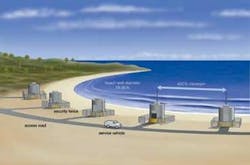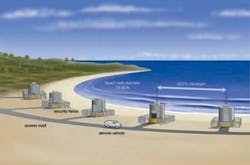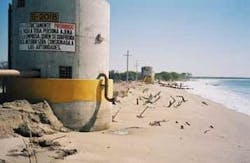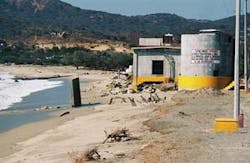Beach wellsvs.open surface intake
By Nikolay Voutchkov
Beach wells offer an attractive option for small seawater desalination plants; however some of their advantages over open ocean intakes diminish for desalination plants with capacity over 20,000 m3/day.
Seawater intakes should deliver continuous flow and high quality source water over the entire useful life of a desalination plant. Currently, two types of intake facilities are used: subsurface beach wells and open surface intakes.
Beach wells are usually located on the seashore in close vicinity to the ocean. These intake facilities are relatively simple to build and the seawater they collect is pretreated via slow filtration through the subsurface sand/seabed formations in the area of source water extraction. Raw seawater collected using beach wells is often of better quality in terms of solids, silt, oil and grease, natural organic contamination and aquatic microorganisms, compared to open seawater intakes. Sometimes, beach intakes may also yield source water of lower salinity.
Open surface intakes for large seawater desalination plants are typically complex facilities, including intake piping that extends several hundred to several thousand metres into the ocean. Source water collected through open intakes usually requires pretreatment prior to reverse osmosis desalination. New open ocean intakes could potentially entrain more aquatic organisms than beach wells because they take raw seawater directly from the ocean rather than source water pre-filtered through coastal sand formations.
Beach wells have proven economic for plants of capacity smaller than 4,000 m3/day, but open surface ocean intakes have found significantly wider application for large seawater reverse osmosis (SWRO) desalination plants. Worldwide, only four operational SWRO facilities with capacity larger than 20,000 m3/day use beach well intakes. The largest SWRO facility with beach wells is the 54,000 m3/day Pembroke plant in Malta.
Several key factors must be taken into account when assessing the viability of using a beach well intake for a large desalination plant facility with production capacity over 20,000 m3/day.
Site suitability. The findings of a detailed hydrogeologic investigation determine the suitability of a site before construction of a beach well intake begins. The factors used to make this assessment are the following:
• the transmissivity/productivity of seashore geological formations;
• thickness of the beach deposits;
• potential for beach erosion;
• and the existence of nearby fresh water source aquifers, which could be affected by beach well operations or have measurable effect on beach well water quality.
Geological conditions that favour beach well intake construction are permeable sand formations that transmissivity exceeds 1,000 m3/day/m, and which depth extends to 15 metres or more. Beaches exposed to accelerated erosion could have a profound effect on intake beach well system structural integrity, performance and useful life.
Seashore environmental impact. Beach wells are typically located within several hundred meters to the ocean. Many wells are needed to supply an adequate amount of water for a large seawater desalination plant, so construction of these facilities would disturb the seashore environment.
If site-specific geological conditions allow, high-productivity horizontal (Ranney) beach wells could be used to reduce the number of the individual wells needed. This well yields 8,000 m3/day to 20,000 m3/day of source water per individual well. Under a hypothetical best-case scenario, a 40,000-m3/day desalination plant, which requires 80,000 m3/day of intake flow, would need a minimum of four operational and one standby beach well of unit capacity of 20,000 m3/day to provide enough source water.
If Ranney wells are used, the minimum distance between individual wells would be 120m, and the footprint of the beach well-affected seashore area would be at least 30m-wide by 610m-long. Therefore, the minimum area of seashore impact as a result of construction of beach wells for a 40,000-m3/day SWRO plant would be 30m x 610m = 18,3000 m2 (four acres).
For comparison, construction of a new open ocean intake for a 40,000-m3/day seawater desalination plant would require a beach area of less than two acres.
Visual and aesthetic effects. Beach intake wells for large seawater desalination plants are often constructed as large-diameter caissons and are tall above-ground concrete structures that have a visual and aesthetic effect on the shore line. Typically, pumps and service equipment conveying the water from a large-size beach well are located above the wet well of the caisson. Beach wells are usually located in close proximity to the ocean, so the well intake pumps must be installed at an elevation that assures protection of well intake pumps and associated auxiliary equipment from flooding. Therefore, the height of the structures of large intake wells with above-grade pump houses may exceed 3m above the beach ground level. Although the above-grade pump house could be designed in virtually any architectural style, this facility and its service roads and controlled access provisions would change the visual landscape of the seashore.
For comparison, open coastal intakes are lower-profile structures that may blend better with the coastal environment and its surroundings. If the desalination plant is co-located with a power plant, construction of new on-shore structures or facilities is typically not required.
Need for source water pretreatment. Beach wells yield better intake water quality than open seawater intakes in terms of seawater turbidity and silt density index, two of the key parameters associated with the selection and sizing of desalination plant pretreat-ment systems. Many assume that beach wells typically eliminate the need for seawater pretreatment prior to reverse osmosis desalination. Findings from a number of beach wells for SWRO plants worldwide indicate that some desalination plants using beach wells may face a costly problem - high concentrations of manganese and/or iron in the intake water. Unless removed before the reverse osmosis membrane system, iron and manganese may quickly foul cartridge filters and SWRO membranes, and render the desalination plant inoperable. The treatment of beach well water, which naturally contains high concentrations of iron and/or manganese, requires chemical conditioning and installation of conservatively designed pretreat-ment filters ahead of the SWRO system. This costly pretreatment may significantly reduce the benefits of beach wells as compared to an open seawater intake, which do not typically have iron and manganese source water quality problems.
Oxygen concentration of discharge. Beach well water has a very low dissolved oxygen (DO) concentration, usually less than 2 mg/l and often varying between 0.2 and 1.5 mg/L. The SWRO treatment process does not add an appreciable amount of DO to intake water; therefore the SWRO system concentrate would have the same or lower DO concentration.
The low DO concentrate discharge from a well intake desalination plant could cause oxygen depletion and stress to aquatic life if it is discharged to the ocean or a river; therefore it may need to be re-aerated before surface water discharge. For comparison, the concentrate from SWRO plants with open intakes have DO concentrations of 5 to 8 mg/L, which is adequate for disposal to the ocean without re-aeration. If disposed to a wastewater treatment plant outfall, this concentrate will actually help in terms of the DO of the discharge blend, taking into consideration that wastewater plant effluent usually has lower DO level.
Summary
Beach wells offer advantages for small seawater desalination plants, but these diminish significantly for large-scale plants. Uncertainties related to large-beach well productivity, capacity, useful life and intake water quality could significantly increase the cost of water production. These factors should be taken into consideration before selecting the most viable intake system for large membrane seawater desalination plants.
Author's NoteNikolay Voutchkov is the senior vice president of technical services for Poseidon Resources Corporation, based in Stamford, Connecticut, USA. Email: [email protected]



